形容词和副词的用法原创课间
图片预览

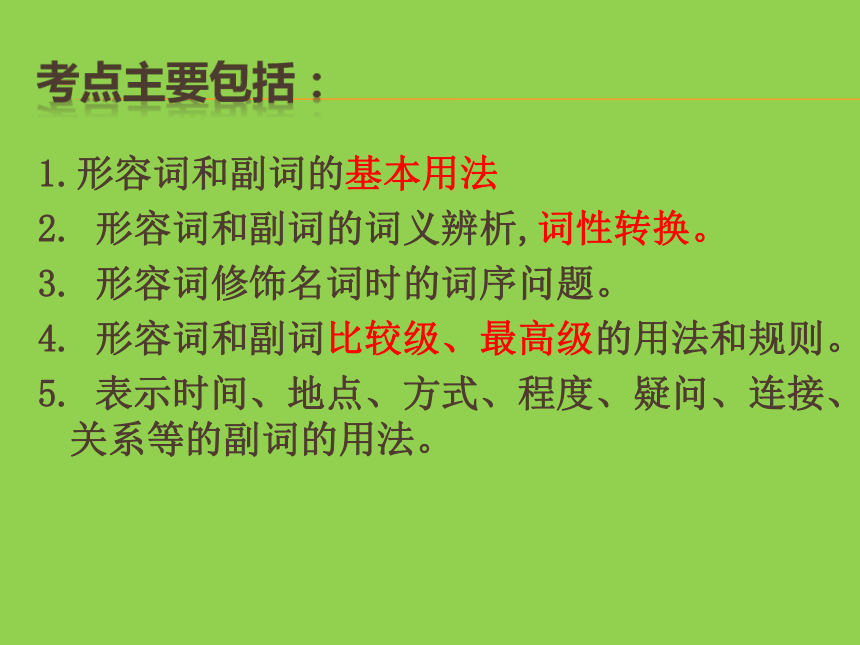

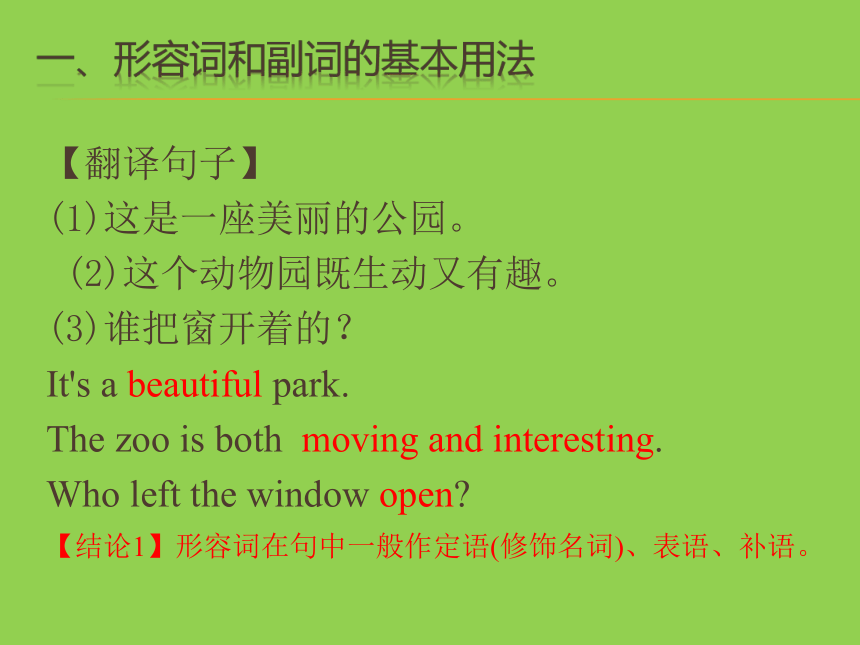



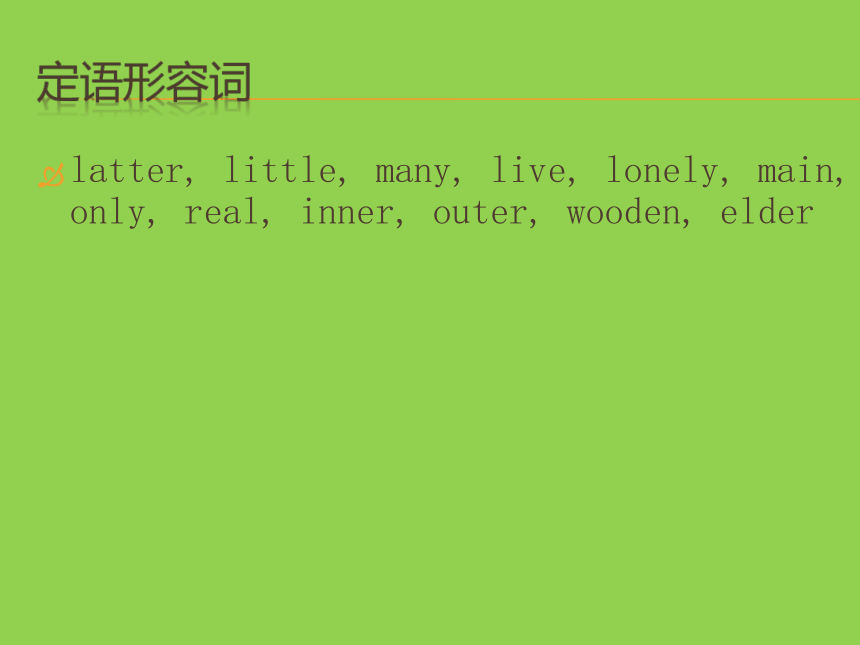
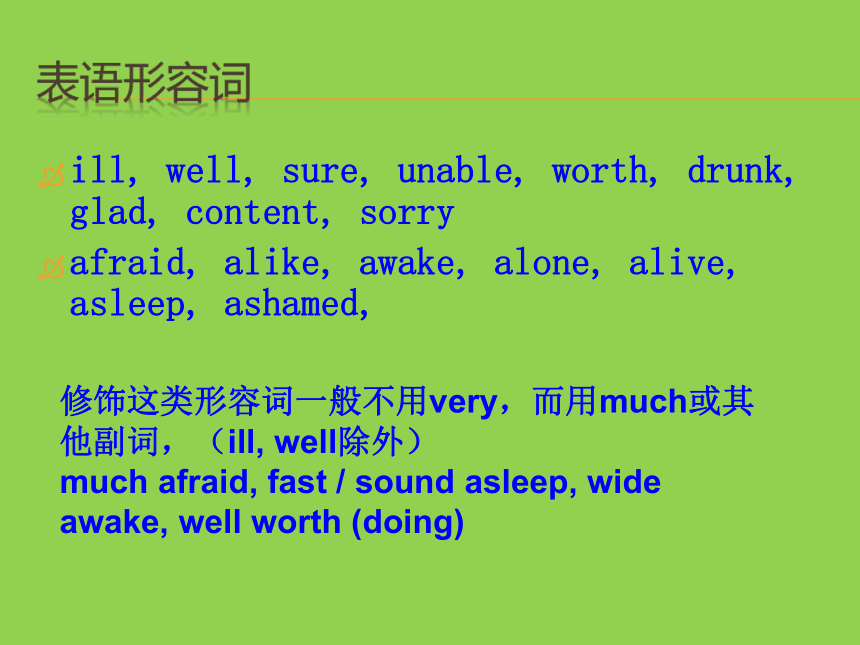


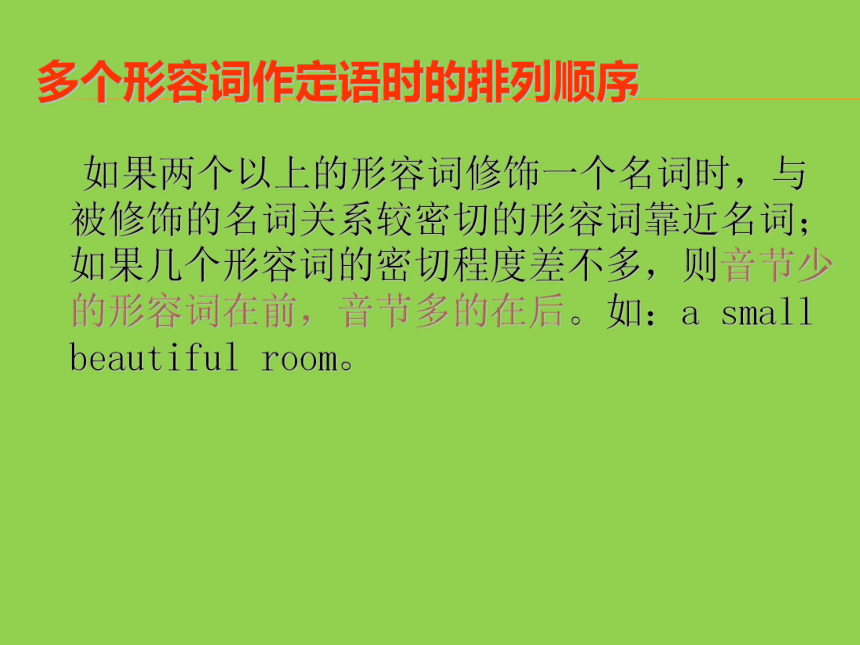
文档简介
课件44张PPT。形容词和副词的用法
1.形容词和副词的基本用法
2. 形容词和副词的词义辨析,词性转换。
3. 形容词修饰名词时的词序问题。
4. 形容词和副词比较级、最高级的用法和规则。
5. 表示时间、地点、方式、程度、疑问、连接、关系等的副词的用法。
考点主要包括:形容词形容词(adj.)用来修饰名词或代词, 表示人或事物的性质、状态和特征。一、形容词和副词的基本用法 【翻译句子】
(1)这是一座美丽的公园。
(2)这个动物园既生动又有趣。
(3)谁把窗开着的?
It's a beautiful park.
The zoo is both moving and interesting.
Who left the window open?
【结论1】形容词在句中一般作定语(修饰名词)、表语、补语。主语+系动词+表语常用系动词:
表判断或状态的:be look seem sound smell taste feel appear
表变化的:become turn get grow go come
常接形容词做宾补的词 make / Keep/ Leave/ drive/find/feel/consider/think ( it) +adj
Eg: make me happy / make the room dirty
Eg: keep the desk tidy
Eg: leave the door open
Eg: I consider him honest.
He thinks it unnecessary to learn English.
二、形容词的种类定语形容词
表语形容词
以-ly 结尾的形容词
复合形容词
定语形容词latter, little, many, live, lonely, main, only, real, inner, outer, wooden, elder
表语形容词ill, well, sure, unable, worth, drunk, glad, content, sorry
afraid, alike, awake, alone, alive, asleep, ashamed,
修饰这类形容词一般不用very,而用much或其他副词,(ill, well除外)
much afraid, fast / sound asleep, wide awake, well worth (doing) 以-ly 结尾的形容词
elderly, lively, lovely, orderly, silly, ugly, smelly, deadly
friendly, motherly, manly, comradely
monthly, timely, daily, newly, weekly复合形容词构成ten-year, two-man
life-long, world-famous,
red-hot(炽热的), dark-blue
tired-looking, ordinary-looking
hard-working, fast-moving
peace-loving, kite-flying,
mouth-watering(令人垂涎的; 非常好吃的)
kind-hearted
hard-won(难得的,来之不易的 ), newly-made
snow-covered, hand-made; four-storeyed,
three-legged(有三条腿的,三脚的 )
难得的,来之不易的 多个形容词作定语时的排列顺序如果两个以上的形容词修饰一个名词时,与被修饰的名词关系较密切的形容词靠近名词;如果几个形容词的密切程度差不多,则音节少的形容词在前,音节多的在后。如:a small beautiful room。常用的顺序为:
限定词(those) + 数量形容词(three) + 描绘性形容词(beautiful) + 大小、长短、高低等形体性形容词(large) + 新旧(old) + 颜色(brown) + 国籍 + 材料(wood) + 被修饰名词(table)
方法1:(县官行令宴国材)方法二:美小圆旧黄,中国木书房?
a nice small round old yellow Chinese wooden reading room.
美代表描述或性质类;小代表大小、长短、高低、胖瘦类;圆代表形状类;旧代表新旧、年龄类形容词;黄代表颜色类;中国代表来源、国籍、地区、出处类;木代表“物质、材料、质地类形容词;书代表用途、类别、功能、作用类;房代表中心名词。
注意某些分词转化而来的形容词表示情感类的过去分词表示心理状态,而现在分词则表示性质,令人……
这类词常见的有:exciting令人激动的
excited感到激动的
delighting令人高兴的
delighted感到高兴的
disappointing令人失望的
disappointed感到失望的
encouraging令人鼓舞的
encouraged感到鼓舞的pleasing令人愉快的
pleased感到愉快的
puzzling令人费解的
puzzled感到费解的
satisfying令人满意的
satisfied感到满意的
surprising令人惊异的
surprised感到惊异的
worrying令人担心的
worried感到担心的
形容词的位置【完成例句】
(7)今天的报纸没有什么新的东西。
There is nothing new in today's newspaper.
(8)人民,只有人民,才是创造历史的动力。
The people, and the people alone, are the motive force in the making of world history.
(9)你还知道别的什么?
What else do you know?(10)你认识那个肩上扛一袋米的人吗?
Do you know the man carrying a bag full of rice on his back?
【结论】形容词一般都作前置定语,但在下列情况作后置定语: 1.由 some, any, no, every 构成的复合不定代词的修饰语要后置.如:
something new; nothing serious; anything interesting
2.else 修饰不定代词和疑问代词时,要后置。如:
Nobody else is so silly as you are.
3.不定式短语,动名词短语,分词短语,介词短语做定 语要后置。
如:eg: Do you still remember the afternoon in the first year at college when the professor gave us a chemistry lesson?
4.以 a- 开头的形容词做定语要后置.如:alike, alive, alone, asleep, afraid, awake… 如:
Eg. He is the only man awake at that time.
5.以下词只做后置定语: present (在场的,出席的), involved (有关的), ?concerned (相关的), left (剩下的), objecting (反对的), ?mentioned (提及的), selected (当选的)等。
Eg. the students present (出席的学生)
Eg. the cost involved (所需费用)形容词比较级和最高级变化规则 ? 形容词级的变化规律和级的用法:?
一、形容词级的变化:1、规律变化:
单音词的变化:(四条)①一般情况:?+er(
比较级)?+est
bright--brighter---the?brightest?明亮的
dear--dearer--the?dearest?
clever--cleverer--the?cleverest?
②词末为--e(不发音)+ r --+st eg:fine--finer--the finest nice--nicer--the nicest cute--cuter--the cutest close--closer--the closest white--whiter--the whitest large--larger--the largest free--freer--freest(特殊)
③重读闭音节,末尾只有一个辅音字母的: 双写辅音字母+er--双写辅音字母+est eg:hot--hotter--the hottest big --bigger--the biggest red--redder--the reddest wet--wetter--the wettest sad--sadder--the saddest fat--fatter--the fattest thin--thinner--the thinnest fit--fitter--fittest
④少数以辅音字母+y结尾的双音节 原根词: 变y为i+er 变y为i+est
Eg: easy easier easiest
early earlier earliest
(2)多数多音节形容词,前面加more或most(3)少数形容词的不规则变化倍数表达法的句式倍数表达法主要有以下5种:
(1)A+动词+倍数+as+原级+as+ B
(2) A+动词+倍数+比较级+than + B
(3) A+动词+倍数+the size / length / weight / height of +B
【特别提醒】表示倍数的词始终在前面。 倍数表达法的句式 (1)我们的新房子是旧房子的3倍大。
Our new house was three times as large as the old one.
=Our new house was twice larger than the old one.
=Our new house was three times the size of the old one. 副词的用法副词(adv.)是一种用来修饰动词、 形容词、全句的词,说明时间、地点、程度、方式等概念的词。【完成例句】
(4)你是完全对的。
(5)他昨晚很晚才睡觉。
(6)幸运的是,我没有被撞倒。
You are completely right.
He went to bed late last night.
Luckily, I was not knocked down.
【结论2】副词在句中主要作状语,用来修饰形容词、副词、动词和句子。
一.副词的种类【完成例句】
(14)这本书是很有趣的。
This book is quite interesting.
(15)这男孩已够大,可以上学了。
【结论1】 The boy is old enough to go to school. 副词修饰形容词和副词时,应放在被修饰的词之前,但enough, nearby必须置于其后。二、副词的位置【完成例句】
(16)他总是乐于助人。
He is always ready to help others.
(17)我永远也忘不了那天。
I will never forget that day.
【结论2】频率副词(always, often, usually, never, seldom, hardly, sometimes等)要放在实义动词之前,be动词、助动词、情态动词之后。【完成例句】
(18)幸运的是,他没有被淹死而是被解放军救了起来。
Fortunately, he was not drowned and was saved by the PLA men.
(19)对她来说,她的继母对她很慈善。
Happily for her, her stepmother was kind to her.
【结论3】修饰全句的副词多置于句首,作评注性状语(即发表评论或表明看法的状语)。 1.多个副词同时出现时的顺序
(1)、方式副词→地点副词→时间副词
Eg: She sat quietly in the room for an hour
(2)、在表示动作的动词后面,地点副词或状语通常置于副词前面。They went to school hurriedly after launch(3)小的时间/地点→大的时间/地点
Come to see me at 3 o‘clock in the afternoon.副词的比较级和最高级形式副词和形容词一样,也有原级、比较级和最高级三个等级。其构成方式有规则变化和?不规则变化两种情况。规则变化的一般规律是:单音节词的比较级和最高级在词尾加-er或-est; 多音节词以及-ly结尾的副词(early除外),前面须加more 或most. 不规则的变化式只能采用“各个击破”的办法去记忆。
? 原级???????比较级?????????最高级 hard??????????harder????????hardest???
?fast????????? faster fastest late?? ?????? later?????????latest??????early????? earlier earliest
?quickly? more quickly most quickly ?strongly more strongly most strongly ?carefully??more carefully ?most carefully ?efficiently?more efficiently??most efficiently???? ?? ?????????????????????????????????????????????????????? ?????????????????不规则的形式?原级 比较级 最高级???
?well??????????better?????????best??????
badly?? worse? worst little??????? less ?????????least???????much????? more? most ?far??? ??farther?, further????????farthest, furthest ??? ?????????????????????????????? ??????????? ?
2. 形容词和副词的词义辨析,词性转换。
3. 形容词修饰名词时的词序问题。
4. 形容词和副词比较级、最高级的用法和规则。
5. 表示时间、地点、方式、程度、疑问、连接、关系等的副词的用法。
考点主要包括:形容词形容词(adj.)用来修饰名词或代词, 表示人或事物的性质、状态和特征。一、形容词和副词的基本用法 【翻译句子】
(1)这是一座美丽的公园。
(2)这个动物园既生动又有趣。
(3)谁把窗开着的?
It's a beautiful park.
The zoo is both moving and interesting.
Who left the window open?
【结论1】形容词在句中一般作定语(修饰名词)、表语、补语。主语+系动词+表语常用系动词:
表判断或状态的:be look seem sound smell taste feel appear
表变化的:become turn get grow go come
常接形容词做宾补的词 make / Keep/ Leave/ drive/find/feel/consider/think ( it) +adj
Eg: make me happy / make the room dirty
Eg: keep the desk tidy
Eg: leave the door open
Eg: I consider him honest.
He thinks it unnecessary to learn English.
二、形容词的种类定语形容词
表语形容词
以-ly 结尾的形容词
复合形容词
定语形容词latter, little, many, live, lonely, main, only, real, inner, outer, wooden, elder
表语形容词ill, well, sure, unable, worth, drunk, glad, content, sorry
afraid, alike, awake, alone, alive, asleep, ashamed,
修饰这类形容词一般不用very,而用much或其他副词,(ill, well除外)
much afraid, fast / sound asleep, wide awake, well worth (doing) 以-ly 结尾的形容词
elderly, lively, lovely, orderly, silly, ugly, smelly, deadly
friendly, motherly, manly, comradely
monthly, timely, daily, newly, weekly复合形容词构成ten-year, two-man
life-long, world-famous,
red-hot(炽热的), dark-blue
tired-looking, ordinary-looking
hard-working, fast-moving
peace-loving, kite-flying,
mouth-watering(令人垂涎的; 非常好吃的)
kind-hearted
hard-won(难得的,来之不易的 ), newly-made
snow-covered, hand-made; four-storeyed,
three-legged(有三条腿的,三脚的 )
难得的,来之不易的 多个形容词作定语时的排列顺序如果两个以上的形容词修饰一个名词时,与被修饰的名词关系较密切的形容词靠近名词;如果几个形容词的密切程度差不多,则音节少的形容词在前,音节多的在后。如:a small beautiful room。常用的顺序为:
限定词(those) + 数量形容词(three) + 描绘性形容词(beautiful) + 大小、长短、高低等形体性形容词(large) + 新旧(old) + 颜色(brown) + 国籍 + 材料(wood) + 被修饰名词(table)
方法1:(县官行令宴国材)方法二:美小圆旧黄,中国木书房?
a nice small round old yellow Chinese wooden reading room.
美代表描述或性质类;小代表大小、长短、高低、胖瘦类;圆代表形状类;旧代表新旧、年龄类形容词;黄代表颜色类;中国代表来源、国籍、地区、出处类;木代表“物质、材料、质地类形容词;书代表用途、类别、功能、作用类;房代表中心名词。
注意某些分词转化而来的形容词表示情感类的过去分词表示心理状态,而现在分词则表示性质,令人……
这类词常见的有:exciting令人激动的
excited感到激动的
delighting令人高兴的
delighted感到高兴的
disappointing令人失望的
disappointed感到失望的
encouraging令人鼓舞的
encouraged感到鼓舞的pleasing令人愉快的
pleased感到愉快的
puzzling令人费解的
puzzled感到费解的
satisfying令人满意的
satisfied感到满意的
surprising令人惊异的
surprised感到惊异的
worrying令人担心的
worried感到担心的
形容词的位置【完成例句】
(7)今天的报纸没有什么新的东西。
There is nothing new in today's newspaper.
(8)人民,只有人民,才是创造历史的动力。
The people, and the people alone, are the motive force in the making of world history.
(9)你还知道别的什么?
What else do you know?(10)你认识那个肩上扛一袋米的人吗?
Do you know the man carrying a bag full of rice on his back?
【结论】形容词一般都作前置定语,但在下列情况作后置定语: 1.由 some, any, no, every 构成的复合不定代词的修饰语要后置.如:
something new; nothing serious; anything interesting
2.else 修饰不定代词和疑问代词时,要后置。如:
Nobody else is so silly as you are.
3.不定式短语,动名词短语,分词短语,介词短语做定 语要后置。
如:eg: Do you still remember the afternoon in the first year at college when the professor gave us a chemistry lesson?
4.以 a- 开头的形容词做定语要后置.如:alike, alive, alone, asleep, afraid, awake… 如:
Eg. He is the only man awake at that time.
5.以下词只做后置定语: present (在场的,出席的), involved (有关的), ?concerned (相关的), left (剩下的), objecting (反对的), ?mentioned (提及的), selected (当选的)等。
Eg. the students present (出席的学生)
Eg. the cost involved (所需费用)形容词比较级和最高级变化规则 ? 形容词级的变化规律和级的用法:?
一、形容词级的变化:1、规律变化:
单音词的变化:(四条)①一般情况:?+er(
比较级)?+est
bright--brighter---the?brightest?明亮的
dear--dearer--the?dearest?
clever--cleverer--the?cleverest?
②词末为--e(不发音)+ r --+st eg:fine--finer--the finest nice--nicer--the nicest cute--cuter--the cutest close--closer--the closest white--whiter--the whitest large--larger--the largest free--freer--freest(特殊)
③重读闭音节,末尾只有一个辅音字母的: 双写辅音字母+er--双写辅音字母+est eg:hot--hotter--the hottest big --bigger--the biggest red--redder--the reddest wet--wetter--the wettest sad--sadder--the saddest fat--fatter--the fattest thin--thinner--the thinnest fit--fitter--fittest
④少数以辅音字母+y结尾的双音节 原根词: 变y为i+er 变y为i+est
Eg: easy easier easiest
early earlier earliest
(2)多数多音节形容词,前面加more或most(3)少数形容词的不规则变化倍数表达法的句式倍数表达法主要有以下5种:
(1)A+动词+倍数+as+原级+as+ B
(2) A+动词+倍数+比较级+than + B
(3) A+动词+倍数+the size / length / weight / height of +B
【特别提醒】表示倍数的词始终在前面。 倍数表达法的句式 (1)我们的新房子是旧房子的3倍大。
Our new house was three times as large as the old one.
=Our new house was twice larger than the old one.
=Our new house was three times the size of the old one. 副词的用法副词(adv.)是一种用来修饰动词、 形容词、全句的词,说明时间、地点、程度、方式等概念的词。【完成例句】
(4)你是完全对的。
(5)他昨晚很晚才睡觉。
(6)幸运的是,我没有被撞倒。
You are completely right.
He went to bed late last night.
Luckily, I was not knocked down.
【结论2】副词在句中主要作状语,用来修饰形容词、副词、动词和句子。
一.副词的种类【完成例句】
(14)这本书是很有趣的。
This book is quite interesting.
(15)这男孩已够大,可以上学了。
【结论1】 The boy is old enough to go to school. 副词修饰形容词和副词时,应放在被修饰的词之前,但enough, nearby必须置于其后。二、副词的位置【完成例句】
(16)他总是乐于助人。
He is always ready to help others.
(17)我永远也忘不了那天。
I will never forget that day.
【结论2】频率副词(always, often, usually, never, seldom, hardly, sometimes等)要放在实义动词之前,be动词、助动词、情态动词之后。【完成例句】
(18)幸运的是,他没有被淹死而是被解放军救了起来。
Fortunately, he was not drowned and was saved by the PLA men.
(19)对她来说,她的继母对她很慈善。
Happily for her, her stepmother was kind to her.
【结论3】修饰全句的副词多置于句首,作评注性状语(即发表评论或表明看法的状语)。 1.多个副词同时出现时的顺序
(1)、方式副词→地点副词→时间副词
Eg: She sat quietly in the room for an hour
(2)、在表示动作的动词后面,地点副词或状语通常置于副词前面。They went to school hurriedly after launch(3)小的时间/地点→大的时间/地点
Come to see me at 3 o‘clock in the afternoon.副词的比较级和最高级形式副词和形容词一样,也有原级、比较级和最高级三个等级。其构成方式有规则变化和?不规则变化两种情况。规则变化的一般规律是:单音节词的比较级和最高级在词尾加-er或-est; 多音节词以及-ly结尾的副词(early除外),前面须加more 或most. 不规则的变化式只能采用“各个击破”的办法去记忆。
? 原级???????比较级?????????最高级 hard??????????harder????????hardest???
?fast????????? faster fastest late?? ?????? later?????????latest??????early????? earlier earliest
?quickly? more quickly most quickly ?strongly more strongly most strongly ?carefully??more carefully ?most carefully ?efficiently?more efficiently??most efficiently???? ?? ?????????????????????????????????????????????????????? ?????????????????不规则的形式?原级 比较级 最高级???
?well??????????better?????????best??????
badly?? worse? worst little??????? less ?????????least???????much????? more? most ?far??? ??farther?, further????????farthest, furthest ??? ?????????????????????????????? ??????????? ?
